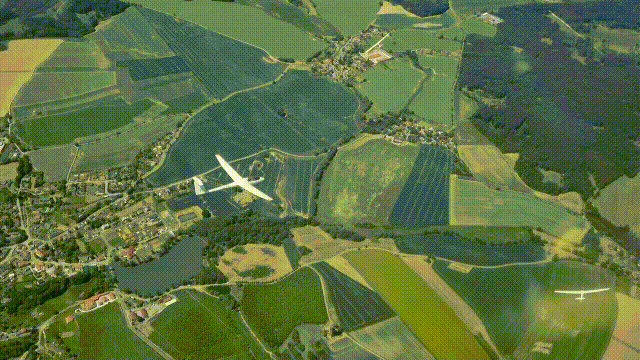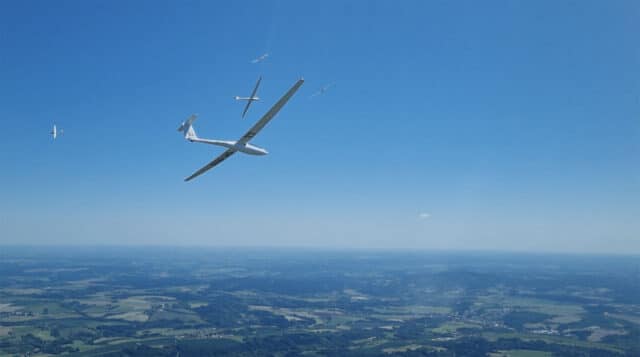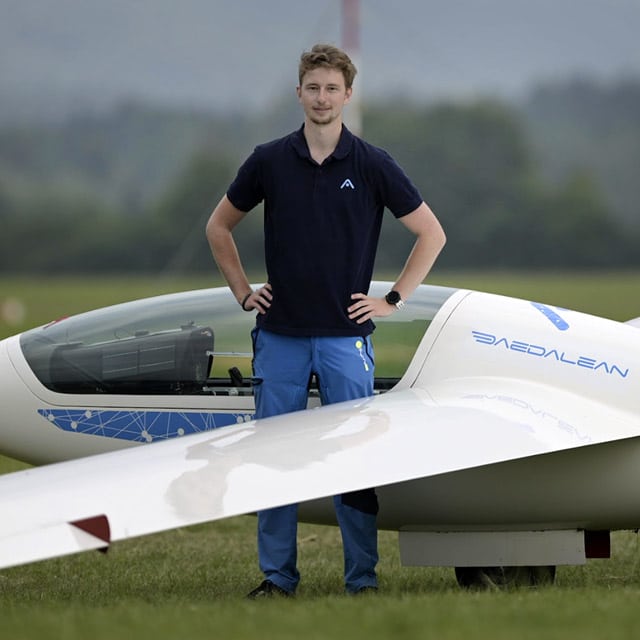Training an AI Copilot To Spot Gliders
My friend Maria at Daedalean wrote this article about how they are using AI to help pilots detect gliders. I thought it was fascinating and Daedalean gave me permission to share it with you! I hope you find it interesting as well.

Training A Helicopter/Airplane AI Copilot to Spot Gliders
Noticing all fixed wing, rotercraft and drones in time
by Maria Pirson
When developing our Visual Traffic Detection technology, it’s crucial to address all kinds of potential encounters. So we collect large data sets on any possible scenario. That way, we can ensure that our software performs reliably and safely in all situations.
With a conventional aircraft, be it an airplane or helicopter, large or small, there is a costly yet well-defined process for data collection. We have consistently conducted such flights over the years, accumulating a significant number of recorded flight hours.
There are, however, less common types of potential intruders: gliders, hot air balloons, paragliders, skydivers, etc, for which our tried-and-true methodology falls short. To accumulate enough hours and create a dataset to make our algorithms failproof for these intruders, we have to be creative and invent new approaches.
Here is the story of how we solved the problem of collecting the necessary data on gliders.

Gliding into danger
Gliders pose a significant risk both to themselves and others. EASA’s annual safety reports show that they have accounted for about 25-30% of aviation midair collisions over the last 10 years.
Regulations do not mandate gliders carry transponders, such as FLARM or ADS-B, and many do not. That means pilots must rely on their ability to spot gliders with their own eyes.
Unfortunately, gliders are hard to see. They have a relatively small, narrow frontal cross-section. Consider the frontal cross-section of a Jonker JS3 Rapture glider compared to that of a Cessna 172 (which fills the skies as the most popular single-engine aircraft ever built).

Viewed head-on, the problem is obvious – the glider cuts a thin silhouette against the sky. And from a distance of 100 to 200 meters, it gets worse. The glider’s narrow wings become nearly invisible.
But the problem is that it’s really hard to collect data on gliders.
Normally, we mount our cameras on a small plane, such as a Cessna, or on a helicopter. Cessnas are, unfortunately, much less maneuverable than gliders, which make sharp turns and sudden pull-ups in taking advantage of developing weather conditions to maintain altitudes.
While helicopters are very maneuverable, they pose a different threat – prop wash. The force of the current of air from its rotors can be so powerful that it could forcefully divert a glider off course. Navigating a helicopter through a group of gliders, as a pilot vividly describes, “would be like putting an elephant in a glass store.”
An additional problem for collecting data on gliders stems from their lack of transponders. Not only does the lack of transponders hinder identifying them in the sky, as mentioned above, but it also makes collecting good data nearly impossible. That’s because good data requires ground truth.
When we collect data, we are essentially videotaping aircraft. That videotape must be analyzed by people to annotate the various objects so as to train the algorithms on what is what – an airliner, a helicopter, a glider. But to make the algorithms even more powerful, we pair the purely visual information of the videotape with information collected from transponders such as FLARM and ADS-B. That information conveys distances and GPS coordinates – the “truth” about the target aircraft’s location over the ground. Together, all this information creates algorithms offering pilots powerful situational awareness.
To approach these problems, Mark Travner, a then-intern at Daedalean and an expert glider pilot, had an idea: Why not use a glider to gather data on gliders?

Competing for safety
Gliding is a competitive sport. During competitions, there are more than 50 gliders flying for 5 to 10 days in a small area, one long flight per day. No problems with maneuverability or prop wash. And all of them are mandated to be equipped with GPS trackers (for scoring) along with FLARM (for safety). The full records for every glider are publicly available afterwards. So Mark entered some glider competition, something he has done nearly every summer for nearly a decade.
But just as one set of problems was solved, another appeared.
Mounting a camera on a glider would cause a loss of around 15-20% of flight performance. This was no small matter. Mark’s glider needed to stay competitive so that he could keep close enough to the field of competitors to record encounters. So, Mark designed and 3D-printed aero cover whose sleek teardrop shape mitigated aerodynamic disruption. (An unexpected side effect for him was to get searched at each airport on the way to the competitions because the aero cover’s shape can appear alarmingly similar to that of an explosive device.)

With the camera through security and mounted on the glider, Mark was ready to take flight. He flew in two big competitions in Central Europe known for attracting large numbers of competitors.
On each flying day, Mark started last, letting everybody go in front so that Daedalean cameras had a nice view of all the other aircraft. He captured hundreds of encounters each day. And a great variety of encounters: Distances ranged from 50 meters to 10 kilometers and included trailing, head-on, turns, dives, pull-ups–everything needed to train a machine on what to look for when scanning the sky for gliders.
This large range of encounters was far better than what we would usually achieve. Normally, we arrange to fly two aircraft to collect data. One of them is equipped with our cameras, and one is a target aircraft. We usually average between 20-30 encounters per hour. With Mark’s glider, we got around 1,000 encounters per hour. Considering that powered aircraft can cost nearly 1000 EUR per hour to operate, the unpowered glider option was extremely cost-effective.

By summer’s end, Mark took flight on
- 13 flying days
- for a total of 60 flight hours,
- during which he collected more than 32 hours of data
- while traversing more than 2,800 kilometers
- and engaging in thousands of encounters.
Our team of annotators is now hard at work analyzing this trove of data so that our Visual Traffic Detection system can help create safer skies for gliders and all those who encounter them.
But this is just the beginning. Next summer’s competitive season is just around the corner.

And beyond that, who’s to say what comes next? Drones? Paragliders? Hang gliders? Skydivers?
Maybe a hot air ballooning competition – after all, Mark already has experience as a co-pilot/navigator at the World Hot Air Ballooning Championships.
I hope you found Maria’s article as interesting as I did!
If you liked the amazing glider photos, you can see more in this Daedalean video about the glider data collection:
Please make Maria feel welcome in the comments and let her know if you have any questions!
-S.








Hi Ms(?) Pirson!
Old friend of mine (he’s passed on now – on the ground) flew gliders as a teenager, then onto powered planes as he got older (and richer!). He claimed it was his glider training that saved his life when the engine in his aircraft quit* over the California desert mountains. Still broke his leg – but lived to tell the tale.
Eventually it was traced to a maintenance error that led to failure of the fuel injection system. After that, he decided to stick to flying twins.
Very good article!
Thank you for sharing it.
The Daedalean work will lead to a very useful safety device.
Congratulations!
Thank you Yves, really (and thanks again to Sylvia for sharing this to her wonderful audience)
I am a glider instructor and also a former tow pilot. Thank you for working on a program that will make aviation safer. Really interesting article!
Thank you so much Harlow :)
I’ve flown gliders as a teenager. At the time, we thought the main risk to gliders was from power lines. I was interested to learn there’s an aircraft risk as well, and the work on mitigating it. Thanks for the article, Maria (and Sylvia)
EASA Annual Safety Review 2023 – Glider/ Sailplane information
Appendix 5 lists the 4 biggest accident/incident causes as off-field landings, aerotow, airborne conflict, and incomplete winch launch.
I’m sure you can glean more wisdom from that review than I can!
Hello Keyan, thanks for your comment :)
Indeed there is a risk. Imagine, for example, helicopter pilots who need to conduct offsite landing in urban areas often (eg police helicopters or medical evacuation services).
Daedalean has power lines detection in the development roadmap, so I hope the next version of the system for general aircraft will have it.
The AI co-pilot is an interesting endeavor. I have some questions:
• what were the reasons that made mounting the camera inside the glider’s cockpit a bad choice?
• is the AI going to help with swarms of birds?
• can it identify balloons, like weather balloons or mylar party balloons?
• does it have a “UFO” mode, i.e. is it possible for the AI to detect an object it can’t identify?
wrt your first question, my guess is that the extremely streamlined canopy (at a sharp angle to the direction the camera was looking) would distort glider outlines in ways that would make them hard to recognize. Our brains can compensate for small distortions; AI might find this more difficult.
Hello Mendel! Thanks for your comment.
1) “What were the reasons that made mounting the camera inside the glider’s cockpit a bad choice?” Mounting the camera inside the cockpit you risk to A: have part of the field of view obstructed, B: introduce unwanted visual effects from the glass which would degrade the image.
2) “is the AI going to help with swarms of birds?” Yes, that is the idea. A human pilot has to use their vision to deconflict with other traffic, including that which may not show up on the radar. Many possible hazards are non-cooperative, and introducing visual aspect into the AI-powered situational awareness allows to detect the things not equipped with an ADS-B transponder, such as birds and drones.
3) “can it identify balloons, like weather balloons or mylar party balloons?” Yes!
4) “does it have a “UFO” mode, i.e. is it possible for the AI to detect an object it can’t identify?” Detecting an object is one problem and identifying it is another. We need to solve both but we can’t identify what is not detected, so everything we detect is at first an unknown.The system was carefully constructed to show you that there is something even if it’s not sure what it is. Suppose there is an air balloon that looks like a massive commercial for a bottle of wine, and then an aircraft flies into it because nobody in the engineering team did not anticipate a bottle of wine in the sky. Similarly, in driving, if someone based the training of their system solely on “this is what a human looks like” and then a person in a chicken costume runs across the road, this design would be fundamentally flawed.
Hope this answers your questions! /Maria